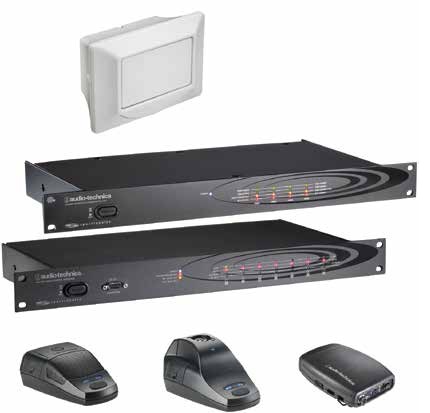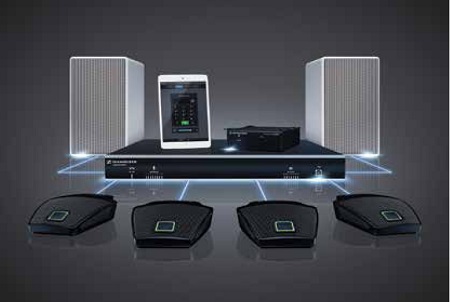A Practical Guide for Choosing Microphones in Corporate Installs

In Q2 2014, Lectrosonics introduced its Digital Secure Wireless system, which features AES-256-CTR encryption technology. The system, similar in form to Lectrosonics’ Venue receiver systems, consists of a receiver frame, individual digital receiver modules, and digital wireless beltpack transmitters. Beyond the world of wired and wireless vocal and instrument microphones, there is a broad range of options suited to corporate applications. Increasingly, it seems, mic manufacturers are also making complete systems available that expand the telephony, telepresence and discussion options available. So which mic is right for your project?
“There are a tremendous amount of selection criteria for any office environment, from a desktop to a huddle room, for a small conference system to medium to large conference rooms, multi-purpose rooms, and corporate boardrooms,” said Randall Lee, director of strategic and channel marketing at Revolabs.
In someone’s office space, for example, the next step up from a simple handset phone might be something like Revolabs’ FLX conference phone. “It’s either VoIP or analog output and has a handset, or you can switch it to go to wireless speakers and two wireless microphones, which you can place around the room,” he said.
With collaboration via WebEx, Lync, Skype and other web apps now commonplace, Revolabs has addressed one shortcoming of USB telephony—low power, thus poor audio quality—with its FLX UC 500, UC 1000, and UC 1500 systems. These USB and IP conference systems utilize external power for a two-way desktop speaker unit, incorporating a mic on each corner and a pick-up range of 12 to 15 feet. The UC 1000 adds a tethered dialer; the UC 1500 supports extension mics for larger spaces.
Options abound from almost every mic manufacturer for boardroom and conference room systems, large or small. Shure’s Microflex system, for instance, offers mics in every form factor. “You’ve got a familiar system with the handheld and bodypack transmitters. You’ve also got tabletop configurations, like goosenecks and boundary microphones,” said product manager Doug Daube. Lavalier, headworn, and overhead mic options also available.

In dense RF environments, Audio- Technica’s SpectraPulse UWB (ultra wideband) digital wireless system offers a practical solution. Offering gooseneck, boundary and bodypack options, SpectraPulse can handle large spaces. Regardless of room size, wireless transmission may be the only option in order to avoid unsightly wiring or the need to drill into expensive furniture. While there are obviously limitations to the number of simultaneous channels supported by any system, thoughtful coordination can allow an enterprise to exceed that limit in practice.
With Microflex Wireless, said Daube, “The most we can get on-air is 40 channels, depending on whether there is any other transmitters in the area.” In real life, he said, “We find a lot of eight-, 12- and 15-channel rooms next to each other. The most I’ve seen in one installation is over 200—that’s eight to 16 mics in 30 to 40 rooms.” He added, “This is the first system we’ve gotten into that allows you to manage that many things over the network.”
A daily selection of the top stories for AV integrators, resellers and consultants. Sign up below.
For those needing larger discussion systems, Shure offers the DDS 5900, supporting 250 users, and the DDS 6000, supporting up to 3,800 participants, with simultaneous interpretation in up to 31 languages. “There are weeklong training sessions to be able to understand and utilize all of the nuances and the software,” Daube reported.
In dense RF environments, Audio-Technica’s SpectraPulse UWB (ultra wideband) digital wireless system offers a practical solution, according to Gary Dixon, sales engineer—installed sound. “It’s a great little system because it’s up out of UHF, up in 6.1 to 6.6 GHz,” he said.
That puts it beyond the spectrum being auctioned off by the FCC and offers another benefit: security. “It’s very high frequency, very low power, so it doesn’t escape rooms very easily. It’s a very secure system, even without encryption, which we can put on top of it,” said Dixon.

With collaboration via WebEx, Lync, Skype and other web apps now commonplace, Revolabs has addressed one shortcoming of USB telephony—low power, thus poor audio quality—with its FLX UC 500, UC 1000 (pictured) and UC 1500 systems. Offering gooseneck, boundary and bodypack options, SpectraPulse can handle large spaces, he added. “We can attach four DRMs [digital receiver modules]; each antenna has a directional pattern of about 80 degrees that can cover up to 75 feet away. With four of those you can cover a decent sized room.” With some basic shielding, he said, separate 14-channel systems can be operated in adjacent spaces.
A-T’s ATCS-60 infrared conference system scales up to larger applications, and incorporates external inputs, multi-language interpretation support and video camera capabilities. “From the receiver-transmitter ‘puck’ that goes on the ceiling to the delegate unit, we’ve got about a 25-foot range,” said Dixon, also noting the inherent security of infrared transmission.
Eight to a dozen pucks can cover an 80-foot by 60-foot room, he added. “Or you can run all 188 channels off of one puck if you need to.”
Revolabs has also avoided problems with the FCC spectrum auctions by building its products on the DECT (Digital Enhanced Cordless Telecommunications) standard, which operates well about UHF. As for security, “We have automatic AE S256 encryption; it does automatic re-keying about every three minutes, so we’ve put these into law firms, banks, Wall Street firms, and some government agencies,” said Lee. Due to the differing DECT spectrum allocations, Revolabs systems support up to 44 mics in the U.S. and up to 76 in Europe and Asia.
In Q2 2014, Lectrosonics introduced its Digital Secure Wireless system, which features AE S-256-CTR encryption technology. The system, similar in form to Lectrosonics’ Venue receiver systems, consists of a receiver frame, individual digital receiver modules, and digital wireless beltpack transmitters.

Sennheiser’s TeamConnect incorporates the company’s new SpeechLine omni and cardioid in-table button and on-table boundary microphones, tying in web and teleconferencing for remote participants as well.

For those needing larger discussion systems, Shure offers the DDS 5900 (pictured), supporting 250 users, and the DDS 6000, supporting up to 3,800 participants, with simultaneous interpretation in up to 31 languages. The company is also targeting corporate video production with its L Series beltpack and camera-mount transmitters, according to Karl Winkler, director of business development at Lectrosonics. “This is a quick-to-set-up system. We’ve added a lot of modern features like infrared sync and Smart Tune. There’s really no need for the users to get technical.”
Lectrosonics makes other systems that are applicable for anything from the boardroom to an annual shareholders meeting. “The new LMb transmitter and the HH handheld transmitter are products that are dead-on center for any kind of in-house corporate wireless mic use,” said Winkler.
For boardrooms or conferences, “The Aspen Series is designed specifically for that application,” he said. Aspen units are available for bridging to telepresence systems or to a Dante network, interconnectivity that is becoming increasingly important in corporate environments and is also available from some of the other mic manufacturers.
“Then there’s an all-in-one box called the Trio,” said Winkler. “That has a couple of power amplifier outputs, a telephone hybrid, an 8x12 auto-mixing matrix; the whole 48x48 mix bus structure. You can use up to eight mics without any expansion. It could be a single-box solution for a smaller conference room.”
Sennheiser also offers a complete system, TeamConnect, which can incorporate the company’s new SpeechLine omni and cardioid in-table button and on-table boundary microphones. Vanessa Jensen, sr. product specialist, installed sound at Sennheiser elaborated, “TeamConnect ties in web and teleconferencing for remote participants. There are speakers, microphones and DSP with echo cancellation built into that, as well.”
Of course, Sennheiser offers a huge range of microphones, wired and wireless, including various goosenecks suitable for its conference systems. “We also have a wired and wireless conferencing system, the ADN,” said Jensen. The ADN system supports up to 400 participants and can incorporate both wired and wireless mics. “If customers have an existing wired system and they want to add some wireless stations for different areas, they can do that.”
One unique corporate package solution, she added, “has been our evolution wireless G3, used in conjunction with our LSP 500 Pro, which is a wireless PA system. You can have presenters wirelessly provide audio through a handheld or a bodypack through the loudspeaker; you can have up to 20 speakers in a group.”
Steve Harvey (sharvey.prosound@gmail.com) has been west coast editor for Pro Sound News since 2000 and also contributes to TV Technology, Pro Audio Review, and other NewBay titles. He has more than 30 years of hands-on experience with a wide range of audio production technologies.
